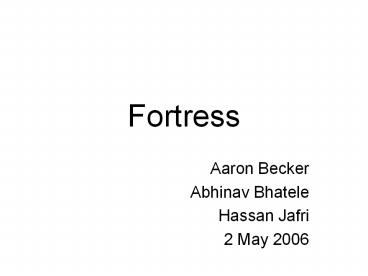Fortress - PowerPoint PPT Presentation
Title:
Fortress
Description:
Want to keep language small, simple and extensible but ... 'Compiler, RTE, profiler, library (and programmer?) cooperate to. compute optimized data layouts' ... – PowerPoint PPT presentation
Number of Views:30
Avg rating:3.0/5.0
Title: Fortress
1
Fortress
- Aaron Becker
- Abhinav Bhatele
- Hassan Jafri
- 2 May 2006
2
Design Philosophy of Fortress
- Goals
- High performance
- Extensibility
- Mathematical notation
- Ease of use/Productivity (type safety, type
inference, abstraction, large standard library) - Note most of this has nothing to do with
parallel programming
3
CJava FortranFortress
- Security model with type safety
- Platform independence
- Large libraries
- Just in time compilation
4
Small Language, Big Libraries
- Want to keep language small, simple and
extensible but still provide lots of
functionality - Solution big libraries with extensive operator
overloading and templating
5
Parallel Programming
- Data model global address space
- Control flow multithreaded, new threads spawned
dynamically - Memory accesses are transactional
- Atomic blocks
- No locks
- Explicit tests for failure/retry
6
Application Code is Simple
- Goal Parallelism is mostly abstracted away in
libraries in the common case (matrix multiply,
fft, etc) - Runtime will dynamically choose data layout and
algorithm based on program characteristics
7
Mathematical Notation
- Goal code that looks like math
- For computational code, want programs that look
like the math theyre based on - Example NAS conjugate gradient
8
NAS CG Serial Code
9
NAS CG Specification
10
Fortress CG Code
- conjGrad/Elt extends Number, nat N,
Mat extends Matrix/Elt,N BY N/, Vec
extends Vector/Elt,N/ /(A Mat, x
Vec) (Vec, Elt) cgitmax 25 z Vec 0
r Vec x p Vec r rho Elt rT r
for j lt- seq(1cgit_max) do q A p
alpha rho / pT q z z alpha p r
r - alpha q rho0 rho rho rT r
beta rho / rho0 p r beta p
end (z, x A z) (z,norm) conjGrad(A,x)
11
Implicit Parallelism
- In Fortress, loops are parallel by default
- for (i,j)?a.indices do ai,j bi cj end
- Reducers (sum, max, etc) are defined in libraries
and may have parallel or serial implementations - y SUMk?1n ak xk
12
Parallelism
- Tuple expressions Each component of the tuple is
evaluated in a separate implicit thread. - Method calls The receiver and each of the
arguments is evaluated in a separate implicit
thread. - Function applications The function and each of
the arguments is evaluated in a separate implicit
thread. - for loops Each iteration of the loop is
evaluated in a separate implicit thread, unless a
sequential generator is used - Comprehensions Each element of the comprehension
is evaluated in a separate implicit thread,
unless a sequential generator is used. - The comprehension as a whole corresponds to a
reduction - Sums and other big operators Each element of the
sum (etc.) is evaluated in a separate implicit
thread the sum as a whole corresponds to a
reduction.
13
Parallelism
- Generators
- Express parallel iterations
- Generator lists in for loops, comprehensions and
reductions - (v1, v2,.) lt- g
- Where g is generator list
- Common generators
- l u Any range expression
- a.indices() The index set of an array a
- 0, 1, 2, 3 The elements of an aggregate
expression - sequential (g) A sequential version of generator
g - Example
- for i lt- sequential(1n) do
14
Data Distribution
- Compiler, RTE, profiler, library
- (and programmer?) cooperate to
- compute optimized data layouts
- Programmer doesnt even know number of
processors! - Many data distributions are implemented at the
library level
15
Distributions
- conjGradE extends Numeric
- (A SparseE, nxn, x En) (En, E) do
- cgitmax 25
- z En A.distribution.arrayn(0)
- r En x.copy(distribution A.distribution)
- p En r.copy()
- rho E rr
- for j ? sequential(0cgitmax) do
- q A p
- alpha rho / pq
- z z a p
- r r - a q
- rho0 rho
- rho rr
- beta rho /rho0
- p r beta . p
- end
- (z, x - A z)
- end
16
Regions
- Regions describe hierarchical structure of
machine (each node is a region) - Tree is limited
- Can not describe all architectures (e.g. grid
layout)
17
Distributed Arrays
- Arrays are spread out on the machine
- Default distribution is determined by fortress
library. - Distributions can be used for customized
parallelism
18
Shared and Local Data
- Objects should be considered to be local by
default. - The sharedness of an object may change on the
fly. - If an object is transitively reachable from more
than one running thread at a time, it must be
shared. - When a reference to a local object is stored into
a field of a shared object, the local datum must
be published. - Its sharedness is changed to shared, and all of
the data to which it refers is also published. - Local variables referenced by a thread must be
published before that thread may be run in
parallel with the thread which spawned it. - A field with value type is assigned by copying,
and thus has the sharedness of the containing
object or closure.
19
Current State of Language
- Language still in a state of flux
- Running simple programs in an interpreter
- Working on running Fortress on the JavaTM Virtual
Machine - Prototype of distributions as a Java library
- Spinning up library effort
- Proving type soundness

